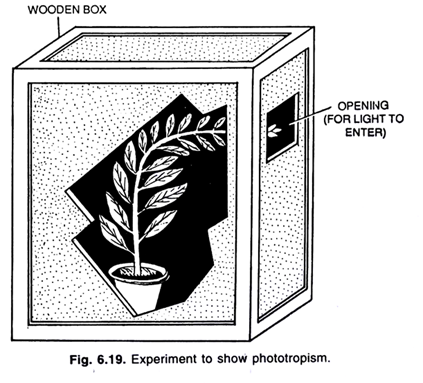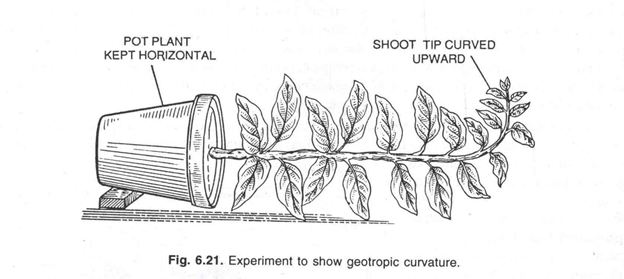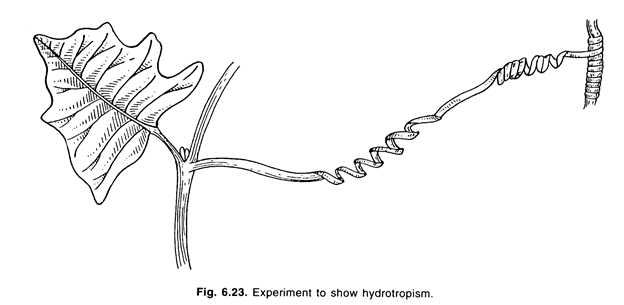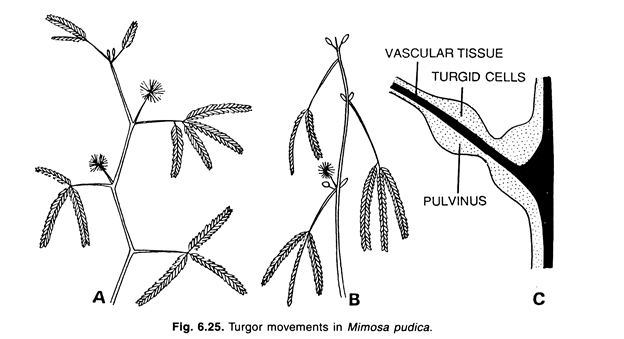The following points highlight the two main types of movements exhibited by plant organs. The types are: 1. Growth Movements 2. Turgor Movements.
Movement by Plant Organs: Type # 1. Growth Movements:
Growth movements are divided into three sub-groups:
(a) Tropic movements occur in response to always related to the direction of the stimulus.
(b) Nastic movements in which the response has no relation to the direction of the stimulus. It is diffused.
(c) Nutation is a movement which is usually independent of the environmental factors. It is characterized by spiral type of growth of the shoot apex.
Tropic Movements:
Most commonly found in the radially symmetrical organs of the plant such as roots and stems; tropic movements are curvature movements caused due to stimulus coming from one side. These movements controlled by the direction of the stimulus occur in one direction due to differences in the rates of growth on the two sides of the moving organs which results in curvature.
A tropic movement may be phototropism (in response to light), geotropism (in response to gravity), chemotropism (in response to chemicals), hydrotropism (in response to water) and haptotropism or thigmotropism (in response to touch).
(i) Phototropism:
Phototropic or curvature movements that take place when plant is provided with artificial or natural light only from one direction. If curvature movement is towards the source of light it is known as positive phototropism and if away from the source of light is known as negative phototropism. Leaves of some plants can keep themselves perpendicular to the source of light and diaphototropic.
One example of phototropic movement is the leaves of Neptunia oleracea which keeping their faces towards sun keep on moving throughout the day turning from east to west. The flowers of Helianthus annuus (sun flower) also move the same way always keeping their faces towards sun. Ovary stalk of Arachis hypogea shows different type of phototropic movements during different phases of its life.
It is positively phototropic when the ovary is unfertilized but after the ovary is fertilized, it becomes negatively phototropic with the result that it bends towards soil and moves the ovary inside the soil. The dispersal of spores in Pilobolus (a fungus) occurs when the sporangiophores have moved towards light.
The phototropic movements are’ thought to be controlled by growth regulatory substances which collect on the side away from the light to increase its growth and result in curvature.
In the laboratory, phototropism can be demonstrated by keeping a potted plant inside a box with a small opening only on one side to provide light. After sometime it will be found that stem has bent towards the opening through which the light is coming.
(ii) Geotropism:
Geotropism is the movement caused in response to gravitational stimulus. Positive geotropism is observed in the primary roots of many plants and negative geotropism in their shoots.
The secondary branches of roots and stems are diageotropic or plagiogeotropic or apogeotropic as they grow laterally at an angle to the gravitational force, called ageotropic are tertiary and further branches of roots which are not sensitive to gravitational stimulus. The flower stalk of poppy flower shows different response to gravitational stimulus during different phases of its life.
It is positively geotropic and keeps the unopened bud hanging down but as the bud opens and changes into flower, it becomes negatively geotropic with the result that the direction of the stalk changes and flower grows upwards. The change in the direction occurs due to unequal growth on the two sides of the stalk.
Depending on the contour, the rhizome of many plants also grows horizontally in the soil due to some reason.
The geotropism can be demonstrated in the laboratory with the help of an instrument known as klinostat which when fixed on it can keep a potted plant rotating with a definite speed.
If two klinostats are taken with potted plants kept in horizontal positions and one is rotated while keeping the other one fixed and stationary, after some time it will be found that the shoot of the plant kept on the fixed klinostat bends upwards showing negative geotropism and root bends downwards showing positive geotropism.
While both the roots and shoots of the plant fixed on the rotating klinostat do not show any bending because the gravitation stimulus in this case is not unilateral as it affects all the sides of the rotating organs equally.
Charles Darwin’s experiment showed that if the shoot and root tips are cut off, there is no response to gravitational stimulus and the region of perception of the stimulus (the tip) is different from the region of response (the zone of cell elongation).
To explain the reason of the curvature and bending of the roots and shoots, various theories have been put forward by Vernon, Nemec, Haberlandt, etc., in the part but the most convincing evidences are for the hormone theory proposed by Cholodny, Dolk, Bennet, Clark, Ball, etc.
According to this theory, the hormones synthesized in the apical meristem uniformly distributed flow towards mature regions due to gravitational force when the plant is upright, but when it is kept in horizontal position, the concentration of flowing hormone becomes more on low side due to gravitational force and less on the other side.
This unequal concentration of hormones on the two sides of the organ concerned results in an unequal growth rate of two sides affecting the tendency of the organ.
(iii) Hydrotropism.
This is the movement of the plant organs to unilateral stimulus of water. This also results in curvature of the organ concerned due to unequal growth on its sides. Roots are positively hydrotropic. The demonstration of the hydrotropism is possible in the laboratory with the help of a shallow sieve in which moist saw dust is kept and some seeds are germinated.
After some time, it will be observed that the radicles come out of holes due to positive geotropism but immediately after coming out start bending up and reenter the moist saw dust through other neighbouring holes of the sieve due to hydrotropism towards water.
(iv) Chemotropism:
Chemotropism is the movement caused due to unilateral stimulus of some chemical. The pollen tube in many cases which moves through the style towards ovary due to chemical stimulus is a good example. Another example can be that of fungus mycelium which when grown in culture medium moves and grows towards the region of the medium where more nutients are concentrated.
(v) Thigmotropism:
Thigmotropism is the curvature movement of plant response to unilateral stimulus of touch and can be observed in so many twiners and climbers. Whenever the supporting organ touches a support, it makes a curvature movement to catch hold the object and tightens its hold. In tendril climbers, the tendrils first show nutation and as soon as its apex touches a support it makes thigmotropic movements to turn round it.
Movement by Plant Organs: Type # 2. Turgor Movements:
These movements are observed in case of sensitive plant like Mimosa pudica. Owing to its sensitivity to touch Mimosa pudica is called “sensitive plant” or “touch me not” It is a herbaceous plant with bipinnately compound leaves. The base of the petiole is swollen which is called pulvinus and similarly smaller pulvinules are present at the base of leaf-lets.
In case the terminal pinnule is struck a blow, cut or burnt or touched, the stimulus is conducted to its base and then to other pinnules. The stimulated pinnules get close up in pairs and drop down in succession from the tip backwards.
The stimulus then passes to other pinnules where the same happening is repeated. If the stimulus is strong, the entire leaf becomes affected and the whole leaf bends downwards. A fast stimulus travels with a speed of 20 cm per second, thus the entire movement is very rapid, taking places in a few seconds.
The movement is caused by differential loss of turgor on the two sides of pulvinus The two sides of pulvinus show different type of cellular organization of which lower half consists of thin walled loosely arranged parenchymatous cells with large intercellular spaces and upper half consists of a bit compactly arranged parenchymatous cells.
As regards to sensitivity, the vascular trace passing through this region shows upper side stable and lower side sensitive. During normal condition on both sides cells of pulvinus remain fully turgid and the leaf is held erect.
The stimulus reaches when in pulvinus, the osmotically active water enters into the cyptoplasm of cells present on the lower half of pulvinus lowering the osmotic pressure of these cells effectively and forcing out water into the intercellular spaces.
These flaccid cells now fail to hold pinnules erect and cause the dropping down of pulvinules and ultimately pulvinus .The whole leaf bends downwards and pulvinus and pulvinules act as hinges.
The stimulus may pass from one leaf to another one. It is believed that the whole mechanism is operated under the influence of some hormone which produced in the stimulated part and travels to the pulvinus through the xylem. The reverse is the case true for restoring normal position.






